STS Continuing Education Survey 2003: Results
Chris Desai, Southern Illinois University
Marilyn Christianson,* Auburn University
Marian Burright, The University of Maryland
*Questions about the content should be addressed to Marilyn Christianson.
The data collection phase of the 2003 STS Continuing Education Survey has been completed. The Committee wishes to thank everyone who participated. The results can be found below.
Marian Burright collected the data. Marilyn Christianson and Chris Desai analyzed it and presented the early results to the STS Council and to the STS Continuing Education Committee at the January 2004 ALA Midwinter Meeting. The Committee hopes the data will be of use in program planning.
Major Findings
- Of the continuing education topics listed by the survey, the items of greatest interest were:
- Improving relations with academic faculty
- Information literacy in the sciences
- Effect of electronic sources on library collections and services
- Subject reference sources
- Presentation and teaching skills
- Respondents themselves suggested the following topic:
- Alternative scholarly communication
- Respondents by far preferred to participate in workshops in person
- Respondents preferred pre-conference workshops and web-based information
Questions 1 to 22: Preselected Training Topic Choices.
The respondents rated the importance of twenty-two preselected training topics on a five-point scale, from " not interested " through " somewhat interested " to " very interested. " " No interest " was computed at zero points, the highest interest at four. The chart below arranges their answers from highest to lowest interest, showing both average and total points.
Improving liaison relations with academic faculty and information literacy in the sciences currently vie for first place. Slightly below these in rank were the effects of electronic sources on library collections and services, subject reference sources, and presentation and teaching skills. The middle-ranked interests might be summarized as " providing access and education in our costly web-based environment. "
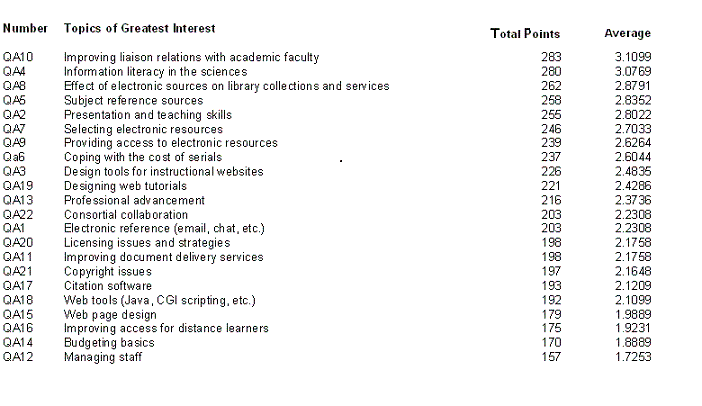
Question 23: Three Topics of Greatest Interest.
For Question 23 respondents were asked to record the three topics in which they had the greatest interest. Many selected their choices from Questions 1 to 22 above. Some answers nearly matched the phrasing or sense of the items above.
These two groups, the matching and almost matching, were tallied together below. The " As Writ " column counts the instances where the request was in substantially the same phrasing. The " Nearly the Same " column counts and describes the other requests whose sense was the same although worded differently, plus those that were for more specific aspects of the same topic. The " Total " column sums the two other columns.
Topics matching or nearly matching items in Questions 1-22:
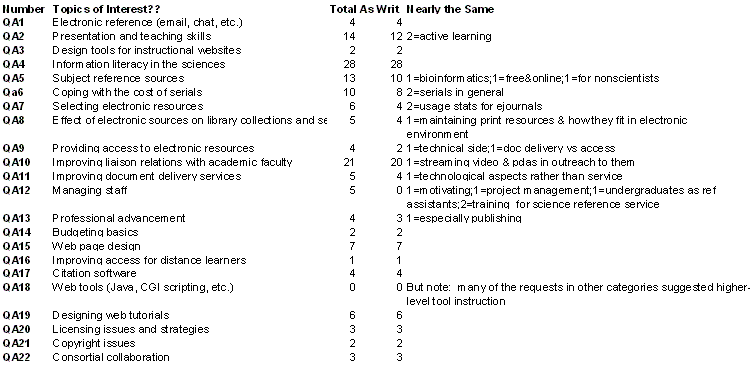
Other respondents suggested unique items. These are collated in the following chart. While most received only one or two " votes, " considerable interest was shown in alternative scholarly communication, " Other2, " below.
Topics Not Easily Categorized by Questions 1-22:
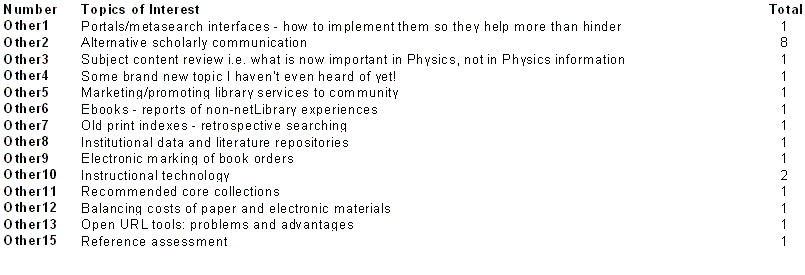
Questions 24 to 30: The Survey Participants.
Question 24: Gender.
As in many surveys of librarians, females outnumbered males. Eighty percent indicated they were female, eighteen percent male, and two percent failed to answer the question.

Question 25: Years Since Graduation.
One third of those answering the survey were relatively new in their careers, having five or fewer years of experience. Another third were very experienced, with sixteen or more years to their credit. In between were another third, with six to fifteen years. That the great mass of librarians are either at the beginning or towards the latter part of their careers can clearly be seen by the graph below.
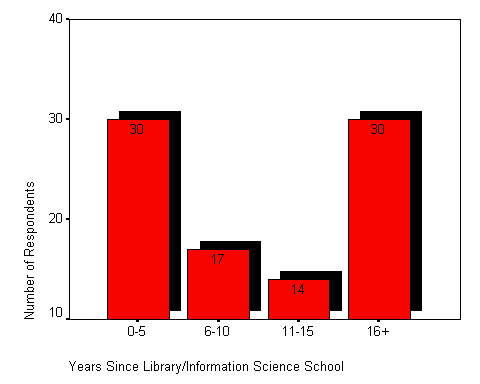
Question 26: Undergraduate Major.
Fifty-four percent, or forty-nine librarians, indicated an undergraduate major in science or technology. The remaining forty-six percent divided their majors among humanities (n=24), social sciences (n=14), education (n=2), and other (n=2).
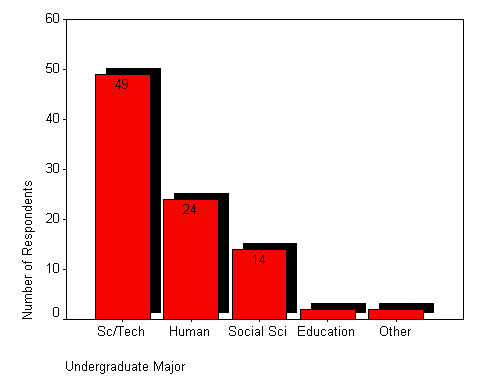
Question 27: Other Graduate Degrees.
Over one fourth have a Masters degree, and almost half of all respondents have a graduate level degree of some kind.
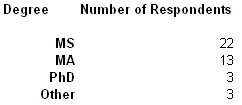
Question 28: Membership in STS.
Eighty-five percent are members of STS.
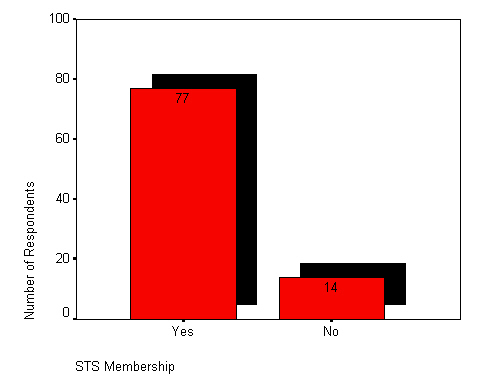
Question 29: STS-L Subscriber.
Ninety-five percent subscribe to the STS listserv.
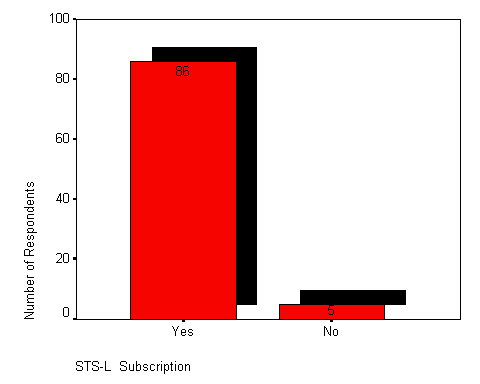
Question 30: Regular ALA Attendance.
Fifty-seven percent regularly attend ALA meetings. This is slightly less than the 2001 survey results, which showed a 60% attendance rate. This 2001 attendance rate prompted the Committee to ask about preferred delivery methods.

Question 31: Preferred Delivery Methods.
Respondents were presented with a list of methods of delivery of continuing education and asked to check all that matched their preferences. Despite the fact that only 57% of respondents regularly attend ALA, slightly down from the 60% reported two years ago, in-person workshops were the preferred method of continuing education. Web-based information took second place. In third place were preconference workshops. Presumably then, in-person preconference workshops are the desire of the respondents if they can attend in person; otherwise, the web suits them. Teleconferences, e-mail tutorials, distance education credit courses, and mentoring generated a certain interest. This last is surprising in that the answers to Questions 32 and 33 show a decided lack of awareness and use of the STS mentor program. Traditional for-credit courses generated the least interest.
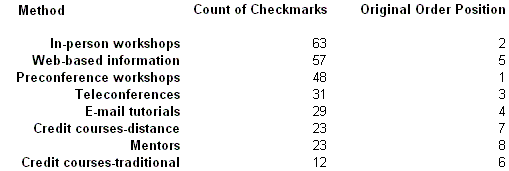
Question 32: Library Mentor Program Awareness.
Question 32 was, " Are you aware of the Science/Technology Library Mentors service (formerly called Collegial Counsel)? " Fifty-five percent knew of this program.

Question 33: Use of Mentor Program.
Respondents were asked if they had used the mentor program. Despite the modest interest in mentoring expressed in answers to, not one respondent had availed himself or herself of the program.

Questions 34/35: Would you like to become a Science/Technology Library Mentor? Topics you would be willing to share.
Seven individuals volunteered to become library mentors. Their names and information were forwarded to the appropriate persons.
Question 36: SLA Conference Attendance at Member Prices.
The question was asked, " Would you attend pre-conference training opportunities and/or workshops at Special Libraries Association (SLA) if you could attend at SLA member rates? "
Eighty-three of ninety-one respondents provided a yes or no answer. Fifty-eight percent of those who answered the question said yes, forty-two said no. The survey did not ask who was a member of SLA, that is, who might attend SLA anyway at SLA member rates. Thus these findings should be interpreted with care.

| Top | STS Continuing Education Committee |